Data on the representation of women artists in Danish and Nordic art institutions
The survey
The following study was undertaken as part of the art historical research project Feminist Emergency: Women Artists in Denmark, 1960-Present led by Assistant Professor Kerry Greaves. The survey was conducted in preparation for the international conference Fast Forward! Women in European Art, 1970-Present held at Louisiana Museum of Modern Art, Humlebæk, on November 17-18, 2021.
The data was collected during the autumn of 2021 by students Marie Vinther Christensen, Agnieszka Olga Czajkowska, and Christina Casco Skadhede at the Department of Arts and Cultural Studies at the University of Copenhagen. The graphs were constructed by research assistant Oliver Holme, MA in art history.
The intention of this statistical survey is to better understand the current state of the representation of women artists in Danish art institutions. While the statistics are not exhaustive and call for further research, they are nevertheless indicative of the reality of gender representation in 2021.
In addition, data was collected from a selection of major art museums in other Nordic countries to provide additional context to the Danish numbers. The data may vary or depend on the systems of registration in the museums and types of collections.
This survey focuses on the representation of women in the arts in Denmark and other Nordic countries. The statistics are limited in that they do not account for critical intersections such as those of social background or race. Nor does it claim to account for or expand upon the complexities of identity and gender expressions. Since the survey specifically investigates the current state of (in)equality between men and women in Danish art institutions, the statistics inevitably reproduce the binary gender categories of men/women artists. The statistics thus represent only a partial accounting of representation of non-binary artists by the few Nordic art institutions that collect this data. Further research is required in order to elaborate on the representation of non-binary and transgender artists in Denmark and the Nordic countries.
The statistics presented here were collected in two main ways: through information provided by the institutions themselves or through information already available on their websites. The statistics are not all-encompassing but represent those institutions of which the project was able to verify the information and/or responded to our requests.
Included in the survey are the 10 most visited museums in Denmark in 2020 (according to Statistics Denmark), along with data collected from 5 main museums in Norway, 4 in Sweden, 2 in Finland, 2 in Iceland, and 22 galleries in Copenhagen.
The statistics serve as a starting point for debate and hope they will stimulate further research on the representation of women in Danish and Nordic art history. We encourage researchers to cite the statistics. The correct citation that should be included with any use of the information is: Feminist Emergency: Women Artists in Denmark, 1960 -Present, Department of Arts and Cultural Studies, University of Copenhagen (https://artsandculturalstudies.ku.dk/research/feminist-emergency/data-on-the-representation-of-women-artists-in-danish-and-nordic-art-institutions/).
Denmark
- Louisiana Museum of Modern Art
- ARoS Aarhus Art Museum
- SMK, Statens Museum for Kunst, the National Gallery of Denmark
- Arken
- Kunsten Museum of Modern Art
- Ny Carlsberg Glyptotek
- Skagens Kunstmuseer
- Trapholt – Museum for Moderne Kunst og Design
- Esbjerg Kunstmuseum
- Nivaagaards Malerisamling
Sweden
- National Gallery of Sweden
- Göteborgs Konstmuseum
- Kristinehamns Konstmuseum
- Moderna Museet
Norway
- Astrup Fearnley Museet
- Henie Onstad Kunstsenter
- Munchmuseet
- KODE Kunstmuseer og Komponisthjem
- Nasjonalmuseet for Kunst, Arkitektur og Design. National Gallery of Norway
Finland
- Museum of Contemporary Art Kiasma
- Espoo Museum of Modern Art
Iceland
- Listasafn Íslands. National Gallery of Iceland
- Listasafn Reykjavíkur. Reykjavik Art Museum
Selected galleries in Copenhagen
2112 Copenhagen, Alice Folker Copenhagen, Benoni Galleri Copenhagen, Bo Bjerregaard, Brigade Copenhagen, Charlotte Fogh Gallery Copenhagen, Edition Copenhagen, Format Art Space Copenhagen, Galleri Christoffer Egelund, Galleri Nicolai Wallner, Galleri Poulsen, Gether Contemporary, Hans Alf Gallery Copenhagen, Galleri Kant, Køppe Contemporary Objects, Marie Kirkegaard Gallery, Martin Asbæk Gallery, Gallerie MøllerWitt, Galleri Nils Stærk, Susanne Ottesen, Tom Christoffersen, V1.
Permanent collections: Gender representation in major Nordic museums
- In general, there are significantly fewer works by women artists than by male artists held in the permanent collections of Nordic art museums.
- Of all the surveyed museums, Museum of Contemporary Art Kiasma and The Espoo Museum of Modern Art, both Finland, have the largest ratio of works by women artists (33.9% and 34%, respectively). Both museums are categorized under the heading “Modern/Contemporary.”
- The surveyed museums that have been categorized as “Art before 1900” have an overwhelming majority of works by male artists. Some notable examples include: Nivaagaards Malerisamling, Denmark (2.4% works by women artists, 89.8% works by male artists, 7.8% works by unknown artists); Ny Carlsberg Glyptotek, Denmark (0.3% works by women artists, 99.7% works by male artists); the National Gallery of Iceland (81.4% works by male artists), and Nasjonalmuseet for Kunst, Kultur og Arkitektur, Norway (81.9% works by male artists). Reykjaviks Art Museum, Iceland has 5.4% works by women artists, and 94.6% works by male artists, while the National Gallery of Denmark, the Statens Museum for Kunst, contains 71% works by male artist, 8% by women artists, and 21% by unknown artists.
- While there seems to be a more equal gender representation among the museums that have been categorized as “Modern/Contemporary,” museums such as Louisiana Museum of Modern Art and ARoS, both Denmark, are still represented by a majority of works by male artists (87.6% and 87.8% respectively).
Contact
For questions or concerns regarding the statistics, contact PI Kerry Greaves (kerry.greaves@hum.ku.dk).

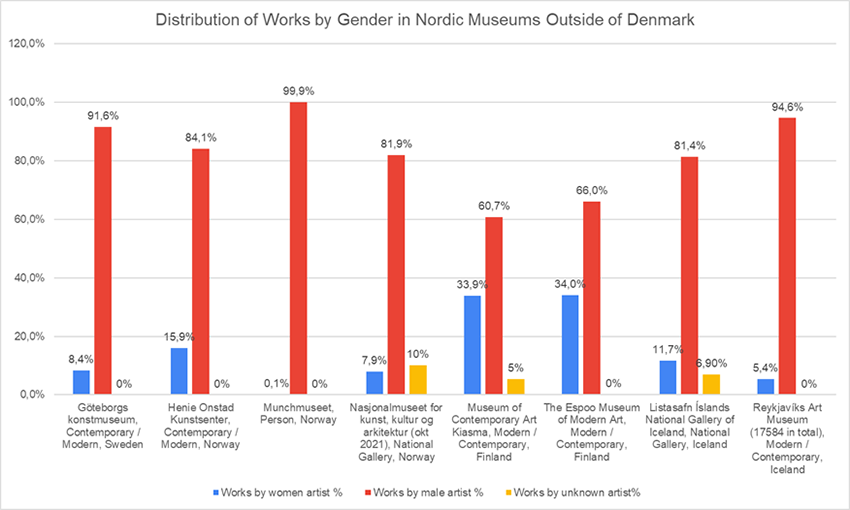
Museum acquisitions: Gender representation in Danish art museums
- All Danish museums in the survey acquired more works by male artists than by women artists within the last five to ten years. Nivaagaards Malerisamling did not acquire any works by women artists between 2010 and 2020.
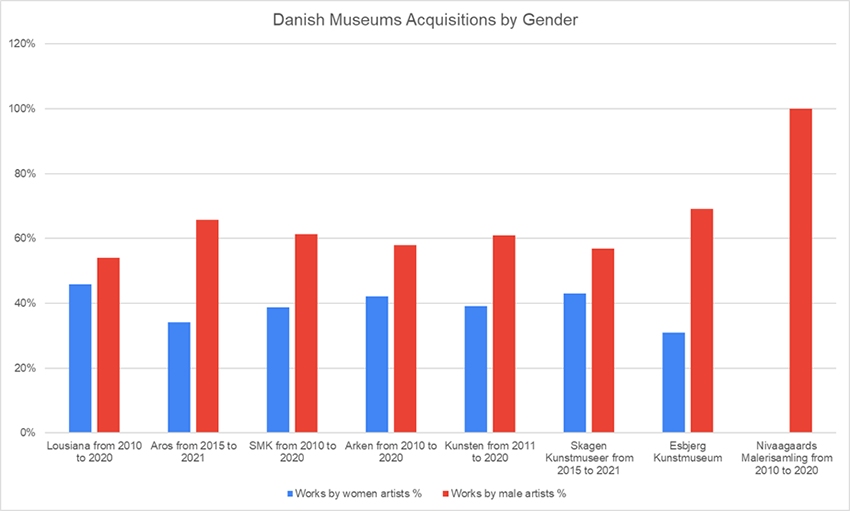
Exhibitions by gender at major Nordic museums
- All the museums in the survey had more solo exhibitions featuring a male artist than those featuring a woman artist, with the exception of Göteborgs Konstmuseum, Sweden, Munch Museet, Norway, Espoo Museum of Modern Art, Finland, and the National Gallery of Iceland. These four museums had more solo exhibitions featuring women artists than those featuring male artists.
- The discrepancy between the number of solo exhibitions featuring women artists versus those of male artists is generally less substantial than that between the ratio of works between genders in the permanent collections of Nordic museums.
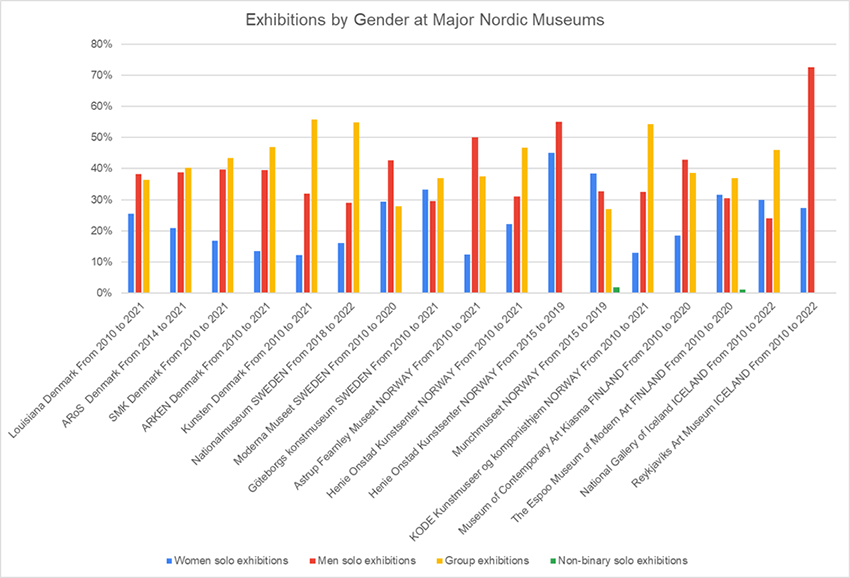
Education: Ratio of Male to Female Students at the School of Visual Arts, Royal Danish Academy of Fine Arts
- Between 2010 and 2020, slightly more female students have been admitted to the School of Visual Arts at the Royal Danish Academy of Fine Arts.
- In 2015, 50.4% of the students admitted were women, while 49.6% were men.
- In 2020, 60% of the students admitted were women, while 40% were men.

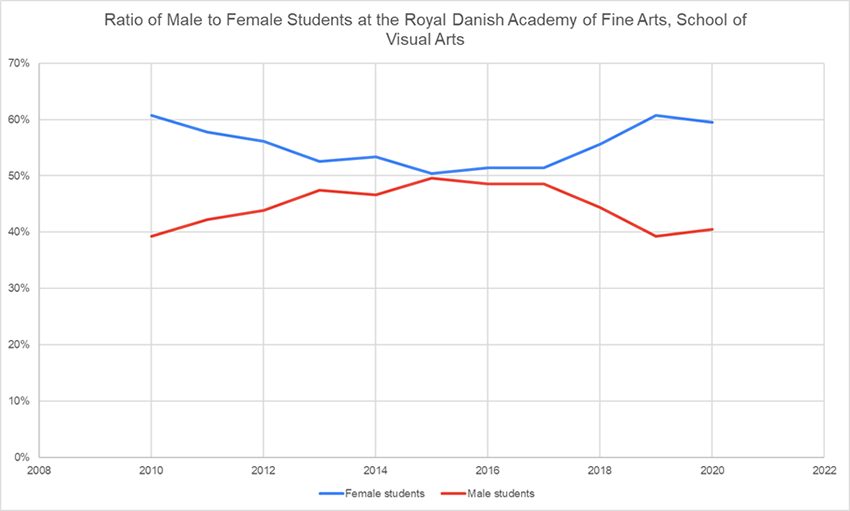
Education data is accessible at Danmarks Statistik (Denmark’s central statistics center): https://www.statistikbanken.dk/INST25. Numbers represent students admitted at the Academy per the 1st of October of the given year.
Galleries: Gender representation in Danish Galleries
- Out of the 22 galleries sampled, 4 represent more women artists than male artists.
- Of the 514 artists represented by the galleries sampled, 180 are women (35%), while 334 are men (65%).

Auctions: Danish auction price differentials
- The data provided by the largest auction house in Denmark, Bruun Rasmussen, reflects the estimates and the prices realized for the ten most expensive artworks sold by the auction house made by women and male artists, respectively, during the period December 2020 to September 2021.
- The statistics show that the ten most expensive artworks by male artists were appraised and sold at notably higher prices than the ten most expensive artworks by women artists during the period.
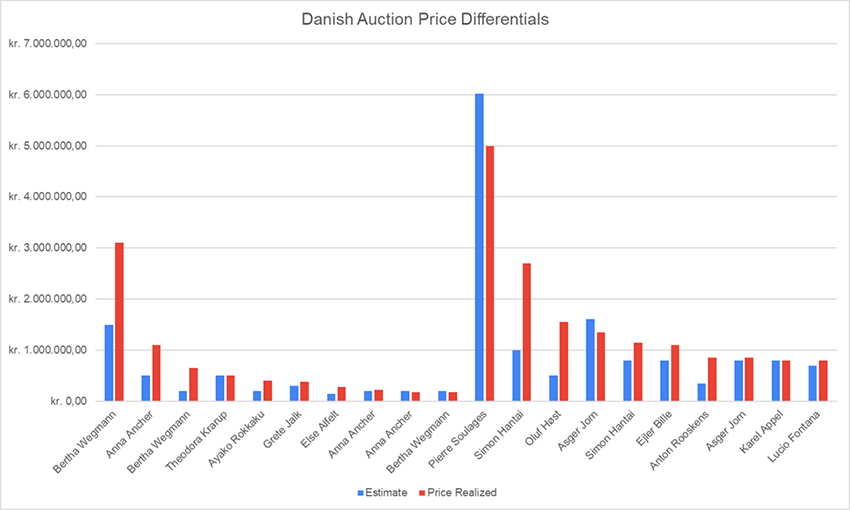
Further information: Recent survey on the representation of women artists in Danish museums by the Association of Danish Museums (ODM)
- The Survey on the Representation of Women Artists in Danish Museums was conducted in 2019 by the Association of Danish Museums (Organisationen Danske Museer, ODM). The statistics cover the period 2004-2019, and the data was provided by approximately half of the art-based museums that are members of the association. The study presented the following four main conclusions:
- The percentage of women artists shown at solo exhibitions: 29%. The percentage of women artists represented in group exhibitions: 34%.
- The percentage of acquired works by women artists: 22%.
- The percentage of female authors in exhibition catalogues and periodicals: 54%.
See the ODM survey (in Danish).
